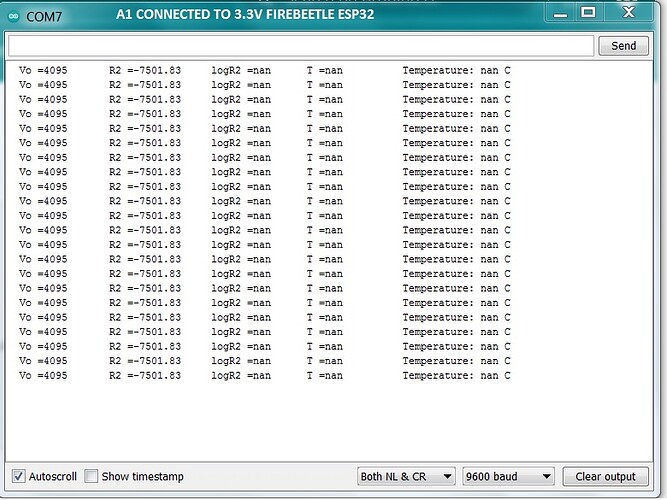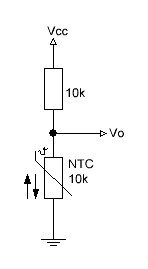TomGeorge:
Hi,
Have you compared the measured resistance with a DMM and the calculated resistance with the code?
Thanks.. Tom... 
Hmmm, you know ...no I should have, and now that I did I read on DMM 11.40K while serial monitor shows : Vo =1710 R2 =13947.37 logR2 =9.54 T =289.48 Temperature: 16.33 C
The above is with the values I had copied from the link I posted in the beginning of this thread.
cattledog:
float c1 = 1.009249522e-03, c2 = 2.378405444e-04, c3 = 2.019202697e-07;
I don't know where you got these parameters from, but c3 is pretty far away from other values I have seen.
For example
https://www.skyeinstruments.com/wp-content/uploads/Steinhart-Hart-Eqn-for-10k-Thermistors.pdf
Did you use a calculator like this to get the parameters?
SRS Thermistor Calculator
After changing the values per first link, the returned result (compared to the the values I was using) is:
Vo =1710 R2 =13947.37 logR2 =9.54 T =290.73 Temperature: 17.58 C
After using the calculator per second link (attached screenshot) I entered the values given by the manufacturer (attached) and adjusted the code:
int ThermistorPin = A0;
int Vo;
float R1 = 10000;
float logR2, R2, T, Tc, Tf;
float c1 = 1.145226154e-3, c2 = 2.296821079e-4, c3 = 1.194648779e-7;
void setup() {
Serial.begin(9600);
}
void loop() {
Vo = analogRead(ThermistorPin);
Serial.print (" Vo =");
Serial.print(Vo);
R2 = R1 * (4095.0 / (float)Vo - 1.0);
Serial.print("\t R2 =");
Serial.print(R2);
logR2 = log(R2);
Serial.print("\t logR2 =");
Serial.print(logR2);
T = (1.0 / (c1 + c2 * logR2 + c3 * logR2 * logR2 * logR2));
Serial.print("\t T =");
Serial.print(T);
Tc = T - 273.15;
// Tf = (Tc * 9.0)/ 5.0 + 32.0;
Serial.print("\t Temperature: ");
Serial.print(Tc);
Serial.println(" C");
delay(1000);
}
Returned result is : Vo =1710 R2 =13947.37 logR2 =9.54 T =290.62 Temperature: 17.47 C
UPDATE: I measured with a DMM between A0 and board's GND and got 1.52v and I see in the latest result above a 1.71v, is this normal? Also please correct me if I am wrong but based on the sketch's coding shouldn't R2 be (3.27v / 1.71v) - 1 * 10000 = 9122 (Instead of 13947.37). Again though, 9122 based on the manufacturer's specs for the thermistor 9122 is about 27C (between 25C and 30C) and I have a 22C. OMG...
3.27v is what I measure with my DMM between the board's 3.3v (where the thermistor is connected) and pin GND.
UPDATE2: OK, maybe this thing is solved but I would like your thoughts: after doing more reading and through trial and error I have calculated Steinhart-Hart model coefficients as: c1 = 1.174407533e-3, c2 = 2.248274514e-4, c3 = 1.324430127e-7; based on the manufacturer's "extreme" readings and middle one at 105C. Thermistor's specs declares at -40C : 31.44855 , at 105C : 0.05931 and at 250C : 0.00263 . I entered the values on this calculator (provided by cattledog) : [SRS Thermistor Calculator](https://www.thinksrs.com/downloads/programs/Therm Calc/NTCCalibrator/NTCcalculator.htm) as -40C : 314485, at 105C : 593 and at 250C : 26 . In the PDF (file name: DG103395) that I have attached above it shows -40C : 31.44855 , 105C : 0.05931 and 250C: 0.00263.
Am I correct to assume 31.44855 is 314485 Ohms , 0.05931 is 593 Ohms, and 0.00263 is 26 Ohms at 250C?
DG 103395.pdf (227 KB)






